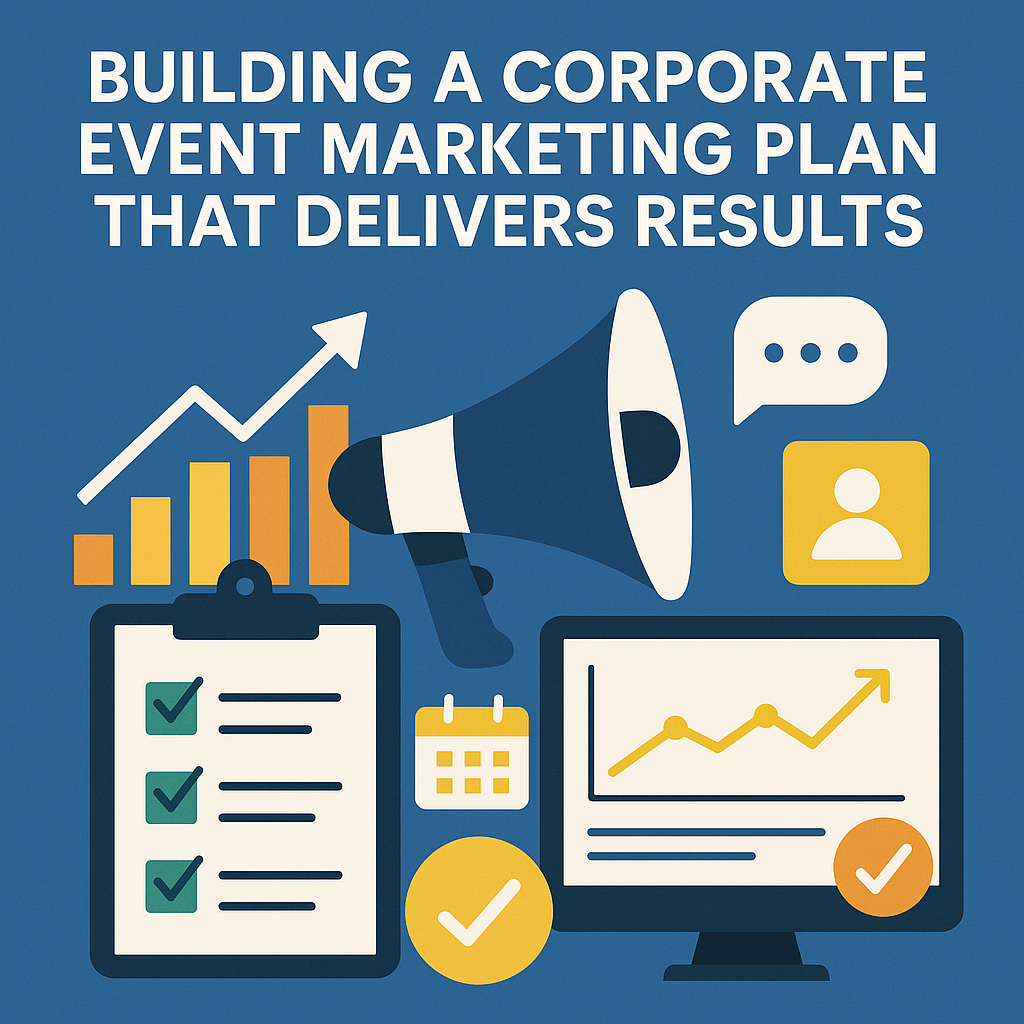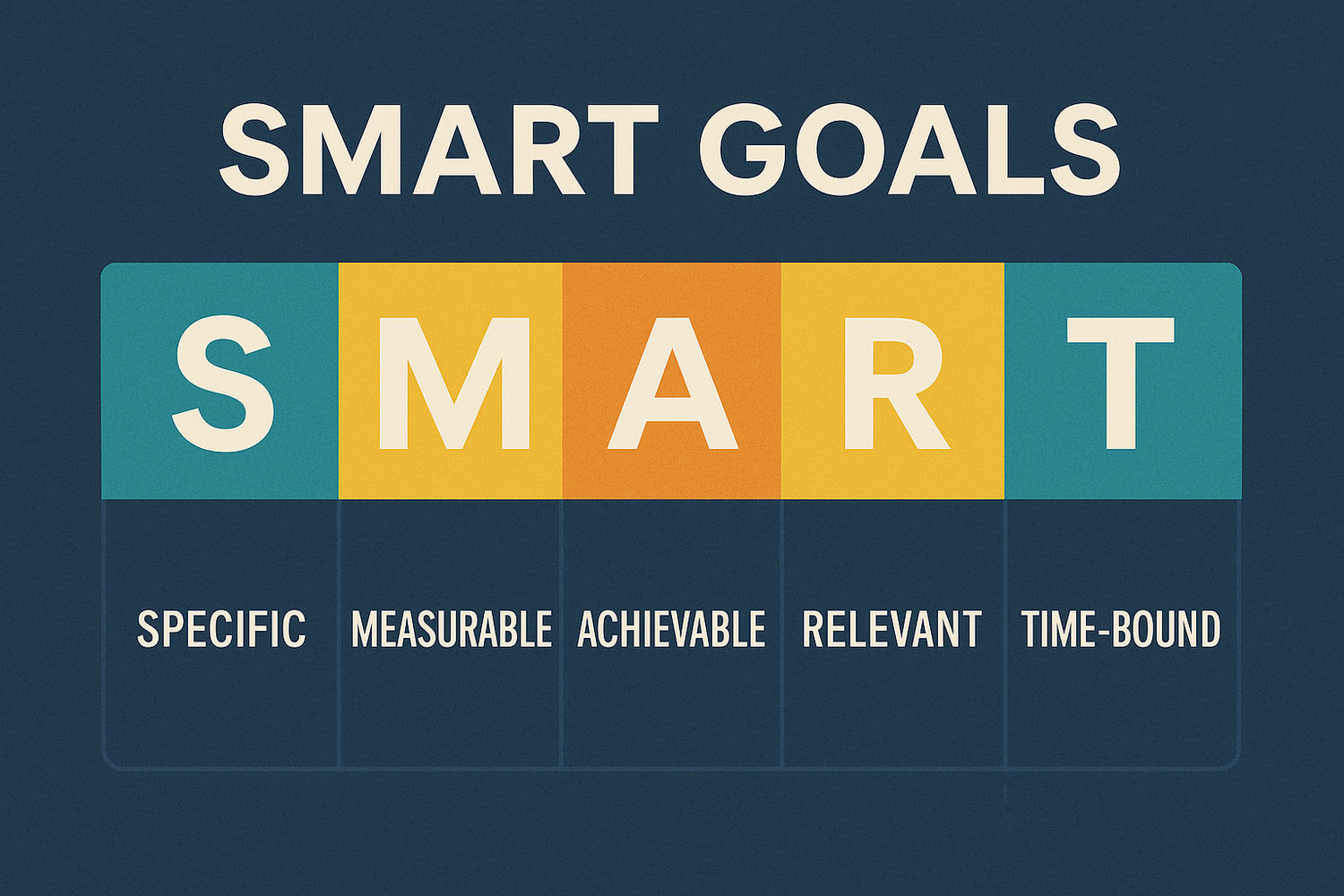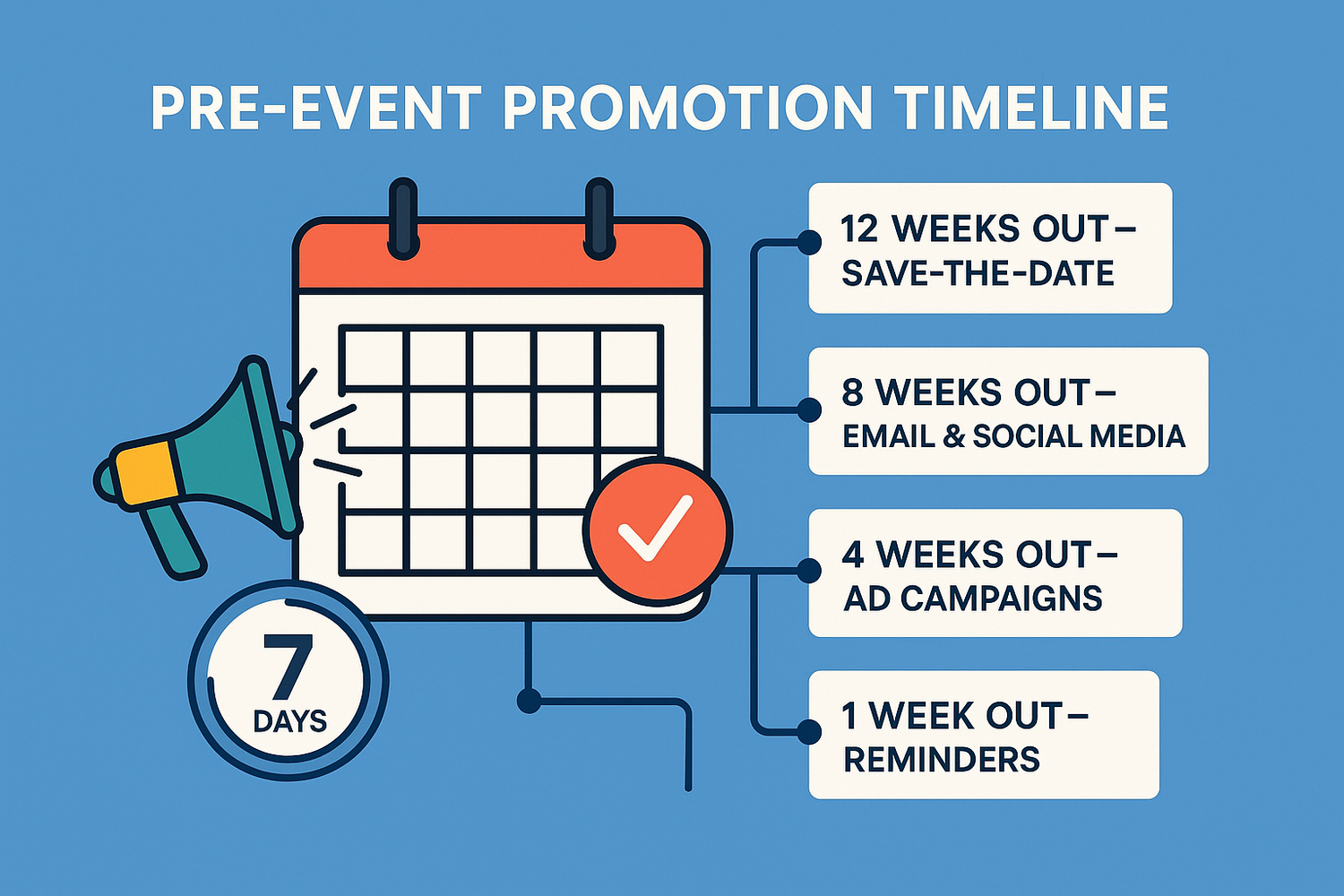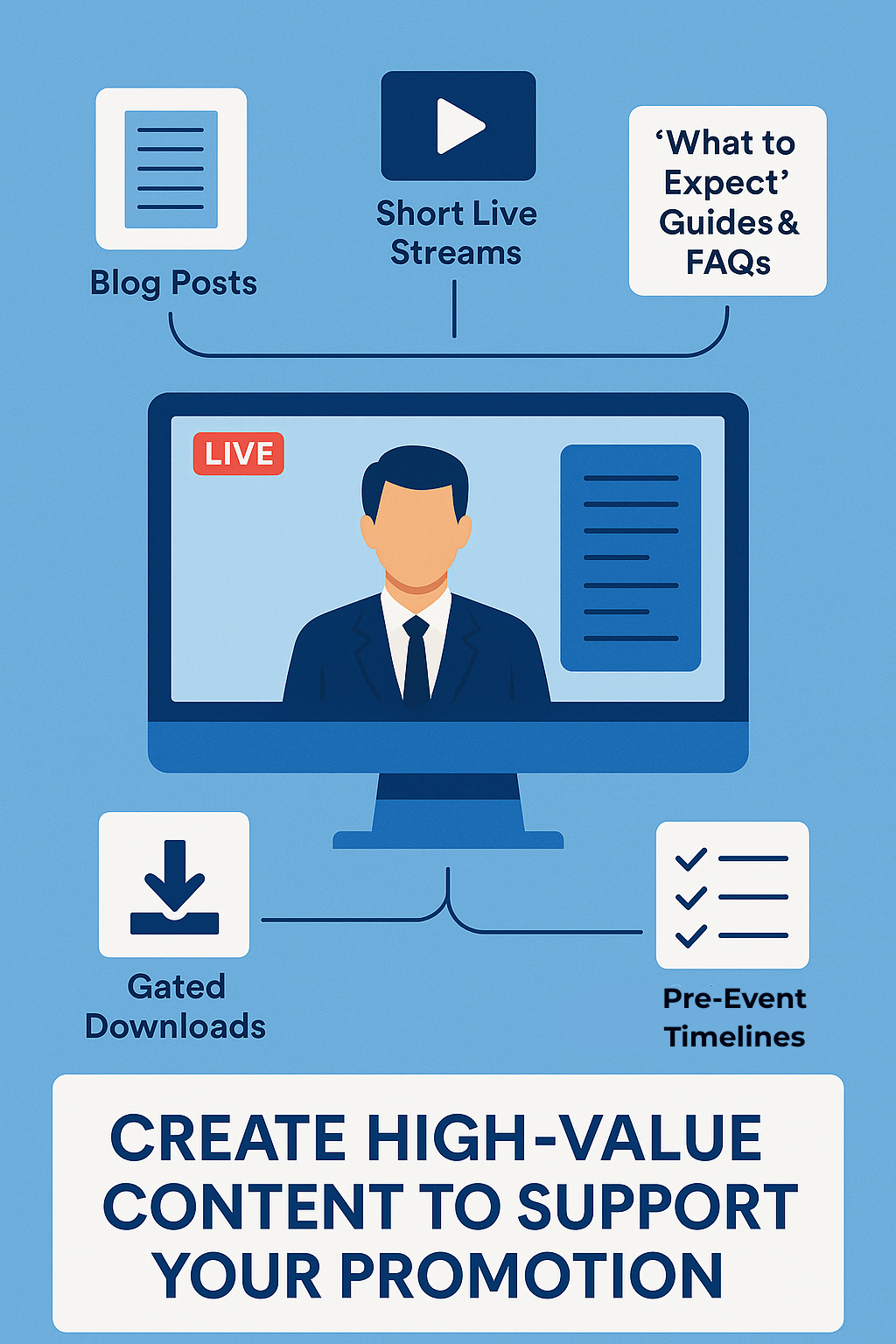Building a Corporate Event Marketing Plan That Delivers Results

Corporate events often come with higher expectations, broader visibility, and more stakeholders. A formal marketing strategy ensures alignment across departments, consistency in branding, and maximum exposure to your target audience.
Without a plan, teams risk poor turnout, disjointed messaging, or missed opportunities to convert potential attendees into long-term clients or advocates. A structured approach helps you:
- Position your brand as a leader in innovation
- Engage attendees before, during, and after the event
- Demonstrate ROI to internal stakeholders
- Increase reach through strategic content marketing, email marketing, and social media campaigns
10 Steps to a Winning Corporate Event Marketing Plan
1. Define Objectives and Success Metrics
Before you promote anything, clarify what success looks like. Are you aiming to generate leads, strengthen client relationships, or educate internal teams?

Your goals should follow the SMART format: Specific, Measurable, Achievable, Relevant, and Time-bound. Consider:
- Registering 300 potential attendees
- Achieving a 40% attendance rate for executive-level guests
- Generating 50 qualified leads from the post-event follow-up
To measure success, align your KPIs with the overall business impact — not just vanity metrics like impressions.
🟢 Real Example: The International Baking Industry Exposition (IBIE) implemented a structured event marketing strategy with specific KPIs across domestic and international markets. The result: attendance goals were exceeded, and engagement increased dramatically. (Freeman)
2. Identify and Understand Your Audience
Successful event marketing strategies begin with a deep understanding of your audience segments. Corporate events may serve:
- Internal teams (e.g., executives, product teams, sales)
- Clients or prospective buyers
- Partners, vendors, or media
Use insights from past events, CRM data, and sales conversations to identify each group’s needs and motivations. This allows you to tailor messaging and select appropriate marketing channels — whether it's a personalized email campaign for VIP clients or LinkedIn posts targeting product managers in tech.
3. Create a Compelling Message and Event Value Proposition
To promote your event effectively, clarify what makes it worth attending. What’s the key takeaway for your audience? How does your event deliver professional or strategic value?
Develop a concise value proposition and ensure it’s reflected across all platforms — from blog posts to live streams to event landing pages. Highlight unique content, featured speakers, or networking opportunities.
🟢 Real Example: Oracle’s Code One developer event used a fully branded digital hub to communicate the event’s core themes. Their consistent messaging helped reach a highly targeted audience of technical professionals and increased participation across global market. (Constant Contact)
4. Build a Pre-Event Promotion Timeline
A strategic timeline ensures consistent, coordinated messaging throughout the pre-event phase. Begin outreach at least 8–12 weeks ahead, allowing you to build momentum with early announcements, staggered speaker spotlights, and time-sensitive offers.

Suggested timeline:
- 12 weeks out – Launch landing page, send save-the-date
- 8 weeks out – Start weekly email marketing cadence and first social media teasers
- 4 weeks out – Begin targeted ad campaigns and gated content marketing downloads
- 1 week out – Send reminders, activate countdowns, share speaker clips
Use tools like Trello, Asana, or Monday.com to coordinate your content calendar and stakeholder approvals.
5. Choose the Right Marketing Channels
An integrated approach across multiple marketing channels is essential to reach today’s diverse corporate audiences. Your strategy might include:
- Email marketing for both internal and external lists
- Social media promotion via LinkedIn and Twitter
- Internal communication platforms like Slack or SharePoint
- Speaker, sponsor, or partner co-promotion
- Paid advertising for broader awareness or targeted outreach
🟢 Real Example: For the Limitless Financial Freedom Expo, Llama Lead Gen ran simultaneous campaigns across Facebook, LinkedIn, and Instagram. LinkedIn produced the highest conversion rate among executives, while Facebook drove the most registrations at scale. (Llama Lead Gen)
6. Create High-Value Content to Support Your Promotion

Content is the engine that drives event awareness and interest. A strong content marketing strategy will educate, inspire, and inform potential attendees while reinforcing your event’s credibility.
Types of content that perform well include:
- Blog posts previewing sessions, speakers, or trends
- Short live streams or speaker teasers on LinkedIn
- Behind-the-scenes planning content for transparency and excitement
- “What to expect” guides and FAQs to reduce friction for registrants
- Gated downloads like “Top 5 Reasons to Attend [Your Event]” in exchange for email signups
Ensure all content reflects your central messaging and points back to your registration page with clear calls to action.
7. Engage Internal Stakeholders and Teams
For events involving internal audiences — such as all-hands meetings or employee innovation days — internal marketing is just as important.
Tips to engage attendees internally:
- Use executive sponsorship: Have C-suite leaders send personal invites
- Promote through internal newsletters, Slack channels, or town halls
- Provide managers with a comms toolkit to share with their teams
- Highlight networking or recognition opportunities within the event
Well-executed internal engagement improves attendance, participation, and post-event momentum.
8. Personalize Messaging for Different Segments
Generic messaging often falls flat in a corporate environment where time is limited and relevance is key. Use segmentation and personalization to craft communications that resonate with each group.
Consider:
- Custom landing pages for job functions (e.g., HR, product, legal)
- Personalized email marketing based on previous attendance or behavior
- Speaker recommendations tailored to industry or use case
- Session highlights filtered by interest or business goals
The more personalized the experience, the more likely your attendee experience will convert interest into action.
9. Monitor Campaign Performance and Optimize in Real Time
One of the key benefits of digital event marketing strategies is the ability to test and adapt. Monitor results closely to ensure your efforts are driving conversions — and make adjustments as needed.

Track metrics such as:
- Open and click-through rates on emails
- Ad performance by creative and audience
- Engagement with blog posts or landing pages
- Real-time registrations and session sign-ups
- Social shares and comment volume on speaker promos
Use these insights to refine your marketing strategy and focus budget where it matters most.
10. Extend Impact With Post-Event Follow-Up
The end of your event is just the beginning of its long-term influence. Following up effectively can help convert attendees into leads, customers, or ongoing community members.
Here’s how to continue the engagement:
- Send thank-you emails with on-demand content
- Share top takeaways in recap blog posts or short videos
- Survey attendees to gain feedback for future improvement
- Offer exclusive follow-up sessions, content downloads, or consultations
- Repurpose recorded live streams or keynotes into bite-sized social content
Providing extended value after the event will enhance brand perception and give your team more touchpoints with qualified prospects.
Final Thoughts: Creating an Event Marketing Plan That Works
Corporate events require more than coordination — they demand strategic alignment, integrated messaging, and measurable outcomes. By applying these 10 steps, you can develop an event marketing plan template that becomes repeatable, scalable, and consistently effective.
When you align goals with content, personalization, and multi-channel execution, you not only increase registrations — you build lasting relationships, elevate your brand, and support real business growth.
Bonus Tip: Don’t Reinvent the Wheel
Save time by customizing an event marketing plan template with the elements above. Include sections for goals, timelines, target personas, and content calendars. Use it across teams and events to maintain consistency while accelerating planning cycles. Need help refining your next corporate event strategy? Check out our additional resources on content marketing, email strategy, and speaker engagement — or contact our team for curated event insights.
